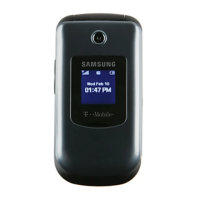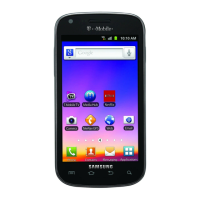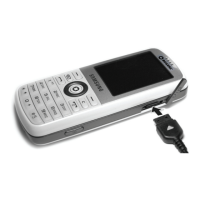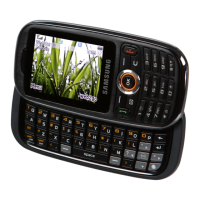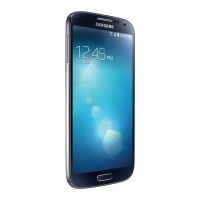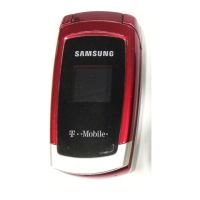
Do you have a question about the Samsung SGH-t219 Series and is the answer not in the manual?
| Model | SGH-t219 |
|---|---|
| Network Technology | GSM |
| GPRS | Class 10 |
| SIM | Mini-SIM |
| Status | Discontinued |
| 3.5mm jack | No |
| Call records | 20 dialed, 20 received, 20 missed calls |
| Video | No |
| Browser | WAP 2.0/xHTML |
| Radio | No |
| Java | Yes, MIDP 2.0 |
| Battery | Removable Li-Ion 800 mAh battery |
| Talk time | Up to 3 h 30 min |
| 2G bands | GSM 850 / 1900 |
| Sound Alert types | Vibration |
| Messaging | SMS, MMS |
| Games | Yes |
| Colors | Black |
Instructions on how to activate your phone, including SIM card installation.
Details on how to charge the phone's Li-ion battery using the provided travel adapter.
Procedure for turning the phone on and off, including password entry if required.
Step-by-step guide for new users to set up their voice mail service.
Methods to access voice mail via keypad or phone menu.
Overview of the phone's key features and capabilities.
Illustration and explanation of the phone's external elements.
Detailed description of each key and its function on the phone.
Illustration and explanation of the phone's external display and speaker.
Explanation of the phone's display screen areas and icons.
Settings for the phone's display and keypad backlight.
Information on accessing help features and t-zones support.
Instructions for making calls, including international and redialing.
How to adjust earpiece and ringer volume during calls.
Procedure for answering or rejecting incoming calls.
Viewing incoming, outgoing, and missed calls.
Instructions to activate and deactivate silent mode for quiet operation.
How to navigate menus and select options using soft keys.
How to navigate phone menus using scrolling and shortcuts.
An outline of the phone's menu structure and options.
How to switch between T9, Number, Symbol, and ABC text input modes.
Guide to using the T9 predictive text input for efficient typing.
How to enter numbers using the number input mode.
How to insert symbols and punctuation marks into text.
Instructions for entering text using the standard ABC mode.
Steps to save contacts to the phone's built-in memory.
Procedure for saving contacts to the SIM card.
How to search for contacts in the phonebook.
How to dial stored numbers using the phonebook.
Setting up and using speed dial entries for quick dialing.
How to edit existing caller groups, including name and picture ID.
Instructions for dialing numbers stored on the SIM card.
How to copy all contacts from the SIM card to the phone.
Procedure for deleting phonebook entries from memory or SIM card.
Creating and sending a virtual business card.
How to check your own phone number.
Setting up and using the Fixed Dial Number list.
Managing contacts: default saving, copying, sorting, and deleting.
Overview of supported message types: Voice Notes, Text, Picture, Voice Mail, etc.
How to record and send voice notes.
Creating and sending simple text messages (SMS).
Creating and sending multimedia messages (MMS).
Viewing received messages, including text, picture, and voice notes.
Accessing messages that have been successfully sent.
Viewing messages that are pending or failed to send.
Accessing messages saved for later editing or sending.
Using predefined text templates to speed up message composition.
Accessing and managing voice mail messages.
Deleting messages from all message boxes.
Configuring default text and push message settings.
Receiving text messages on various topics.
Checking memory usage for messages.
Starting and using instant messaging services.
Setting and updating the phone's time and date.
Customizing various phone settings like language and greeting.
Adjusting display brightness, contrast, and wallpaper.
Customizing ring tones, keypad tones, and alert types.
Configuring network services like call forwarding and call waiting.
Managing phone security features like PIN, password, and lock applications.
Checking memory usage for shared memory, messages, files, etc.
Resetting phone and sound settings to default values.
Managing sounds, images, and memory status.
Downloading and playing Java games (MIDlets).
Using features like alarms, calendar, calculator, and stopwatch.
Accessing and navigating the WAP browser for web access.
Information on RF signals, SAR, and phone safety.
Safety requirements for the travel adapter.
FDA information on wireless phone RF exposure and health effects.
Guidelines for safe phone use while driving.
Recommendations for phone use in various environments.
Information on potential interference with pacemakers and hearing aids.
Safety precautions for use in areas with explosive atmospheres.
How to make emergency calls.
FCC regulations, cautions, and warranty information.
General safety guidelines for phone installation and handling.
Tips for optimizing signal reception and understanding power save features.
Information on network dependency and additional charges for features.
Factors affecting battery life and performance.
Guidelines for safe handling, charging, and disposal of batteries.
Recommendations for cleaning and maintaining the phone.
Details of the limited warranty coverage, exclusions, and obligations.

